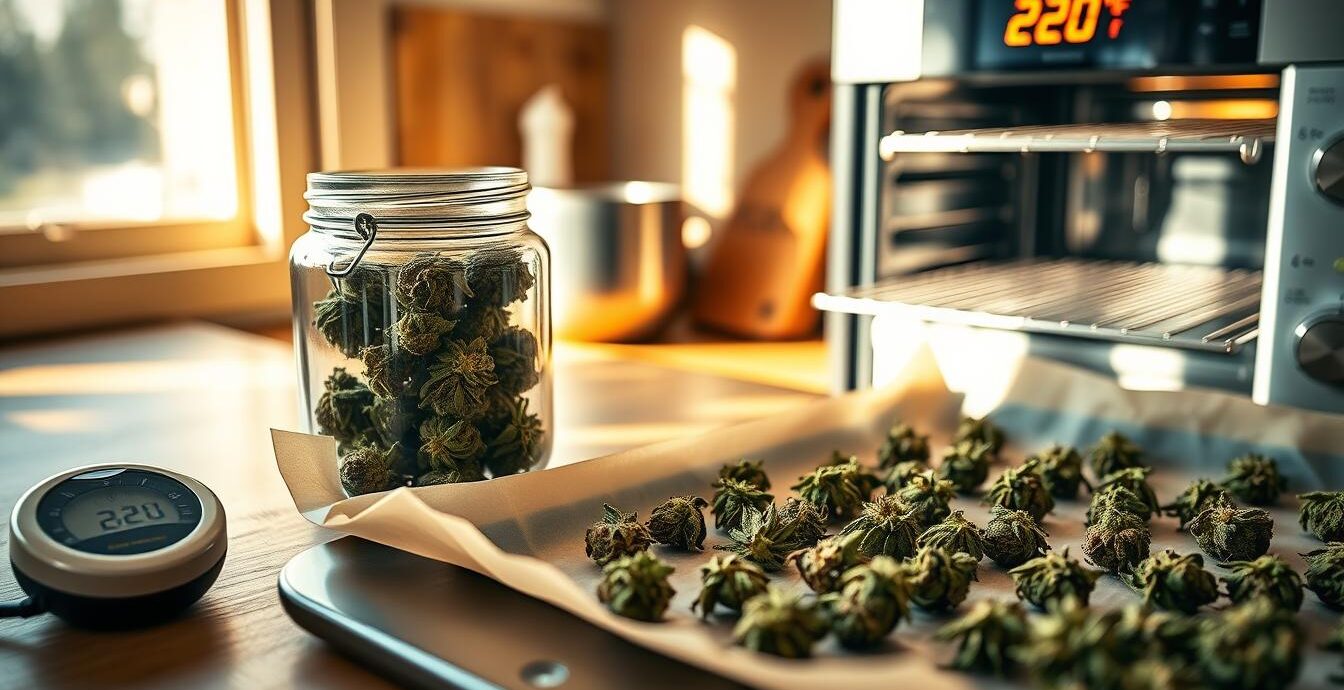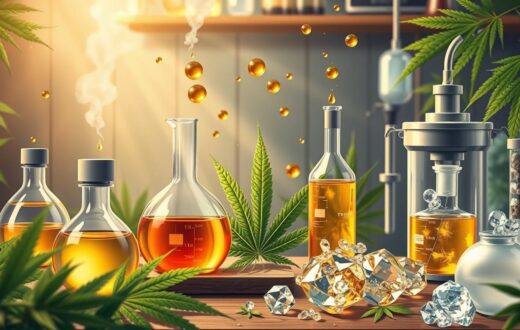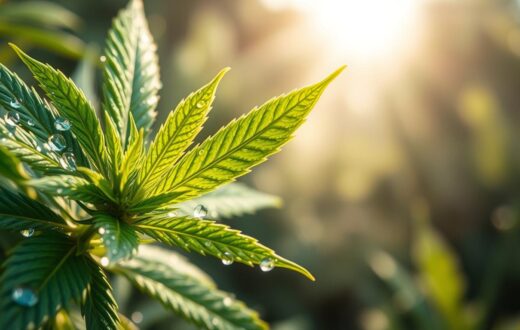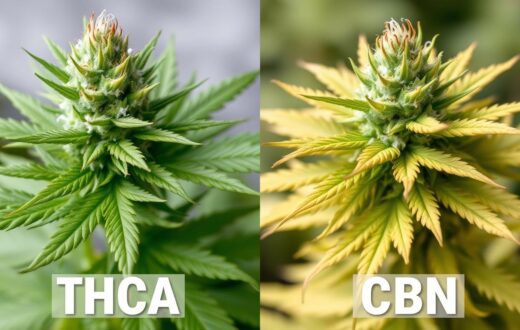Ever wondered why eating raw cannabis doesn’t produce the same effects as smoking it? The secret lies in a process called decarboxylation. This crucial step transforms non-psychoactive THCA into potent THC, unlocking the full potential of your cannabis.
Decarboxylation is key to cannabis decarboxylation and THC activation. At home, you can decarboxylate THCA using simple methods. The most common technique involves baking ground cannabis in an oven at temperatures between 220°F and 245°F for 30 to 40 minutes.
For those seeking precision, the sous-vide method offers excellent temperature control. This approach minimizes cannabinoid and terpene loss during the process. Another option is the Mason jar method, which reduces odor and prevents burning.
Understanding how to decarboxylate THCA is essential for cannabis enthusiasts and medical users alike. This knowledge allows for more accurate dosing and unlocks the full therapeutic potential of cannabis. Ready to learn more about mastering this vital process? Let’s dive in!
Introduction to Decarboxylation
Let’s explore decarbing marijuana. This step is vital for turning THCA into THC. THCA is a non-psychoactive compound in raw cannabis. Heat transforms it into THC, which gives cannabis its famous effects.
What is Decarboxylation?
Decarboxylation is a simple process. It uses heat to change the chemical structure of cannabinoids. In raw cannabis, THCA is plentiful. Heat removes a carboxyl group, turning it into THC.
Importance of Decarboxylating THCA
Why is activating THCA important? Raw cannabis won’t have the desired effects. Decarboxylation is key for making edibles and tinctures. It makes cannabis products more effective.
For the best results, use temperatures between 220°F and 245°F when decarbing in an oven.
Understanding THCA
THCA, or tetrahydrocannabinolic acid, is a key part of raw cannabis plants. It’s the first step to making THC, the part that makes you feel high. But, THCA itself doesn’t make you feel high if you eat it raw.
What is THCA?
THCA is found in the trichomes of fresh cannabis flowers. It doesn’t bind to brain receptors, so it doesn’t make you feel intoxicated. But, when you heat it up, like when you smoke or cook cannabis, it turns into THC.
Benefits of THCA
Even though THCA doesn’t make you high, it might have some health benefits. It could help with inflammation and nausea. It might even protect your brain, which could help with neurological issues.
When you want to get THC, you need to know the difference between THCA and THC. Your choice depends on what you want to feel and how you plan to use it. Knowing about THCA helps you make better choices about your cannabis use.
The Science Behind Decarboxylation
Decarboxylation is key to unlocking cannabis’s psychoactive powers. It turns inactive THCA into the active THC we seek. Let’s explore the science behind this transformation.
How Decarboxylation Works
Heating weed for THC production is a chemical reaction. At 220°F (105°C), THCA loses its carboxyl group. This lets THC bind with our body’s receptors.
Experts often suggest heating cannabis to 240°F for 30-40 minutes. This ensures the best results.
Chemical Changes During the Process
Decarboxylation changes the molecular structure of cannabinoids. THCA in raw cannabis turns into THC. This change depends on the temperature.
At 320°F, about 70% of THCA becomes THC. Higher temperatures, like 392°F, can convert up to 95% of THCA. But, terpenes, which add unique flavors, start to break down above 300°F.
Finding the right temperature is crucial. It ensures both potency and flavor preservation when decarbing cannabis flower.
Methods for Decarboxylating THCA
Decarboxylation is essential for unlocking thc from marijuana. It transforms non-psychoactive THCA into the active THC we love. Let’s look at three popular home decarboxylation methods.
Oven Decarboxylation
Oven decarboxylation is a favorite among many. Preheat your oven to 220°F to 245°F (104°C to 118°C). Grind your cannabis and spread it on a baking sheet with parchment paper. Bake for 30-40 minutes, stirring halfway. This method is simple but can be smelly.
Sous Vide Decarboxylation
Sous vide offers precise temperature control. Put ground cannabis in a sealed, water-safe bag. Then, submerge it in a water bath at 203°F (95°C) for about 90 minutes. This method is odorless and keeps more terpenes than oven decarboxylation.
Microwave Decarboxylation
Microwave decarboxylation is quick but requires caution. Place ground cannabis in a microwave-safe container. Heat in 30-second bursts, stirring between each. Avoid overheating to preserve THC. This method is fast but demands attention to avoid burning your buds.
Proper decarboxylation is key for activating thc from marijuana. Each method has its advantages and disadvantages. Choose the one that suits you best. Always use an oven thermometer for accuracy and grind your cannabis for even heating.
Preparing Your Material for Decarboxylation
Getting your material ready is key when learning to decarboxylate THCA. The right steps help activate THC and boost your cannabis’s potency. Let’s look at the important steps to prepare your material for this crucial process.
Selecting the Right Cannabis Strain
Choose high-quality THCA-rich flower for the best results. Look for vibrant colors and strong aromas. Avoid any signs of mold or pests. The strain you pick affects the final product’s effects, so think about what you want when selecting.
Grinding Cannabis for Better Results
Grinding your cannabis is a vital step in the decarboxylation process. Use a clean grinder to break down the flower to a medium coarseness. This ensures even heat distribution during THC activation. Avoid grinding too finely, as smaller pieces can burn easily. A consistent grind promotes uniform decarboxylation across your material.
Remember, a clean workspace is essential to prevent contamination. By following these preparation steps, you’ll set the stage for successful THCA decarboxylation and create potent, high-quality cannabis products.
Decarboxylation Equipment You Will Need
Cannabis decarboxylation needs specific tools for success. The right gear helps turn THCA into THC. Let’s look at the must-have items for this process.
Essential Tools and Devices
You’ll need a baking sheet, parchment paper, and an oven for oven-based decarboxylation. A grinder is key for even cannabis breakdown. For sous vide, you’ll need an immersion circulator, heat-safe bags, and a large pot.
Some people use specialized herb cookers like the POT by NOIDS. These are convenient but can be expensive.
Safety Precautions and Considerations
Safety is crucial when activating THCA. Always wear gloves and keep your workspace clean. Make sure you have good ventilation to handle smells.
Use oven-safe materials and be careful with hot equipment. The best temperature for decarboxylation is between 200°F and 250°F (93°C to 121°C). This ensures THCA is converted to THC without losing good compounds.
Whether you’re using the oven or sous vide method, keeping the temperature right is essential for success.
Step-by-Step Guide: Oven Method
Decarbing marijuana in an oven is a common way to extract THC. It makes the cannabinoids more potent for edibles or other products. Here’s how to decarb your cannabis efficiently.
Preheating Your Oven
Preheat your oven to 240°F (116°C). This temperature is perfect for activating cannabinoids without losing other good compounds. Use an oven thermometer to ensure the temperature is right, as ovens can be off.
Baking Process for Maximum Efficiency
Grind your cannabis coarsely and spread it on a parchment-lined baking sheet. Bake for 30-40 minutes, stirring halfway. This ensures even heating and complete decarboxylation without drying or burning.
Cooling and Storing
Let the cannabis cool at room temperature after baking. This stops the decarb process and prevents further loss. Store it in an airtight container in a cool, dark place. Proper storage keeps potency high and extends shelf life, making your THC extraction worthwhile.
The Sous Vide Method Explained
Sous vide decarboxylation is a precise way to convert thca to thc. It keeps temperatures stable and reduces odor. We’ll look at setting up your sous vide and the best timing and temperature practices.
Setting Up Your Sous Vide
You’ll need an immersion circulator first. These cost about $200 for a good one. Fill a container with water and attach the circulator. Set the temperature to 203°F (95°C).
Grind your cannabis and put it in a vacuum-sealed or zip-lock bag. Try to remove as much air as you can before sealing.
Timing and Temperature: Best Practices
For the best results, submerge the sealed bag in the water bath for 90 minutes. This method is better than others because it controls the environment. It keeps terpenes and cannabinoids safe.
The precise temperature control prevents overheating. This could damage the THC. The right temperature for the right time is key to success.
After 90 minutes, take the bag out and let it cool. Then, you can open it. Your cannabis is now ready for edibles, oils, or other products. This method is great for avoiding the strong smell of oven decarboxylation.
Microwave Decarboxylation Technique
Decarbing cannabis flower in a microwave is quick. It’s great when you’re in a rush. But, you must be careful.
Advantages of Microwave Decarboxylation
Speed is the big plus of microwave decarboxylation. It takes only 1.5 to 3 minutes. This is faster than oven methods.
Step-by-Step Instructions
First, grind your cannabis flower evenly. Put it in a microwave-safe container with a loose lid. Set your microwave to max power.
Heat in short 20-30 second bursts, stirring each time. It should take about 9 minutes total.
Watch your cannabis closely. Overheating can harm it and lower its potency. Aim for a temperature of 220°F to 250°F for best results.
After it’s done, let it cool before using it in edibles or other products.
Evaluating Decarboxylation Effectiveness
Learning how to decarboxylate THCA is key. It turns raw cannabis into a potent form. Let’s look at signs of success and common mistakes to avoid.
Signs of Successful Decarboxylation
Decarboxylated cannabis changes color to light brown and gets oily. Its smell gets stronger. These signs mean THCA has turned into THC. The best temperature for this process is between 220°F and 240°F (104°C to 116°C).
Avoiding Common Mistakes
One big mistake is using too high a temperature. This can ruin the potency of your cannabis. Stick to 230°F (110°C) and bake for 30 to 45 minutes.
Another error is not baking long enough. Use an oven thermometer for precise temperature. Also, don’t open the oven too often. This keeps the temperature steady. By avoiding these mistakes, you’ll learn how to decarboxylate THCA well, making your cannabis products more potent.
Using Decarboxylated Cannabis
After decarboxylation, you unlock many uses for your cannabis. This step is key to activate THCA and other cannabinoids. It makes them ready for various uses.
Making Edibles with Decarboxylated THCA
Decarboxylated cannabis is great for making edibles. You infuse it into butter or oil. For example, a cup of butter infused with 28% THC flower can have about 61 mg of THC per tablespoon.
Keep in mind, the conversion rate isn’t always 100%. So, start with small doses to see how potent it is.
Infusing Oils and Tinctures
Decarboxylated cannabis is also good for making oils and tinctures. For oils, mix it with a carrier oil like coconut or olive oil. For tinctures, soak it in high-proof alcohol.
These products are versatile. You can use them in cooking, add them to drinks, or apply them topically.
When using decarboxylated cannabis, keep the temperature between 220 – 260°F. Use a timer to avoid burning and keep the potency. Whether making edibles, oils, or tinctures, knowing how to activate THCA is key to a great cannabis experience.
Storage Tips for Decarboxylated Cannabis
After decarbing marijuana, it’s important to store it right. This keeps its potency and quality. The right storage methods help keep your THC extraction effective for longer.
Best Practices for Long-Term Storage
Use airtight glass containers to keep your decarboxylated cannabis fresh. These jars block air and keep the flavor. Don’t use plastic containers, as they can change the taste and strength of your product.
Store the jars in a cool, dark place. This prevents the breakdown of cannabinoids.
Preventing Loss of Potency
Heat, light, and moisture harm decarbed cannabis. Keep it away from these to keep its strength. For long-term storage, vacuum-seal and freeze it. This can keep your cannabis potent for up to a year.
Following these tips ensures your decarbed cannabis stays fresh and potent. Whether making edibles or infusing oils, well-stored cannabis will give you the best results in your THC extraction process.
Troubleshooting Decarboxylation Issues
Converting thca to thc can sometimes be tricky. Let’s look at common problems and how to solve them. This way, you can get the best results when heating weed for thc activation.
Common Challenges and Solutions
Uneven decarboxylation is a common issue. To solve this, stir your cannabis halfway through. If your weed gets too dry, add a bit of water before using it.
For better terpene preservation, try the sous vide method. It uses 176°F for 1-2 hours. This helps keep fragile compounds safe.
FAQs About the Decarboxylation Process
What’s the best temperature for decarbing? Research shows 235°F for 65 minutes or 278°F for 57 minutes. The ideal temperature is about 220°F.
Can I decarb in a jar? Yes, use a mason jar that can handle heat up to 392°F. Simmer it in boiling water for 90 minutes.
How do I store decarbed cannabis? Keep it away from sunlight, moisture, and heat. This helps it last longer. Remember, proper decarboxylation is crucial for making effective edibles, oils, tinctures, and topicals.
Conclusion: The Benefits of Decarboxylation
Decarbing cannabis flower is key to unlocking marijuana’s full potential. It turns THCA into THC, the active part of the plant. For those who use cannabis, knowing about decarboxylation is crucial.
Importance for Cannabis Users
Decarboxylation makes sure users get the most from their cannabis. It’s especially important when making edibles. Without it, the products might not be as strong.
For medical users, it’s even more critical. It makes THC and other good stuff in edibles and oils work better. This means users can get the right dose and feel the effects more consistently.
There are many ways to decarb cannabis. Oven baking at 240°F for 30 minutes is common and focuses on THC. Slow cookers use lower heat for longer times. Vaporizing is cleaner, and smoking does it through burning.
Learning about decarboxylation lets users make cannabis products just for them. It’s good for fun or for health reasons. Knowing how to do this helps users get the most out of THC in marijuana.
Disclaimer
At Marifinder, we aim to give you the facts on cannabis decarboxylation. Our guide on how to decarboxylate THCA is for learning only. It’s key to know that cannabis laws differ by place. Always check local rules before doing anything with cannabis.
Legal and Health Considerations
We’ve shared ways to decarboxylate cannabis, like using an oven, sous-vide, or microwave. But safety and legality come first. The best temperature for decarboxylation is between 220°F to 250°F (105°C to 121°C) for 30 to 45 minutes. Always follow local laws, no matter the method.
If you’re thinking about using cannabis for health reasons, talk to a doctor first. They can give advice based on your health and any other meds you’re taking. Remember, THCA powder might help with pain and inflammation, but it affects people differently.
Responsible Use and Dosage
For newcomers, start with a small dose of 5-10 milligrams of THCA powder. If you’re more experienced, you might start with 10-20 milligrams. The THC strength in cannabis depends on how well it’s decarboxylated. Always use responsibly and know the possible risks and side effects of cannabis.















